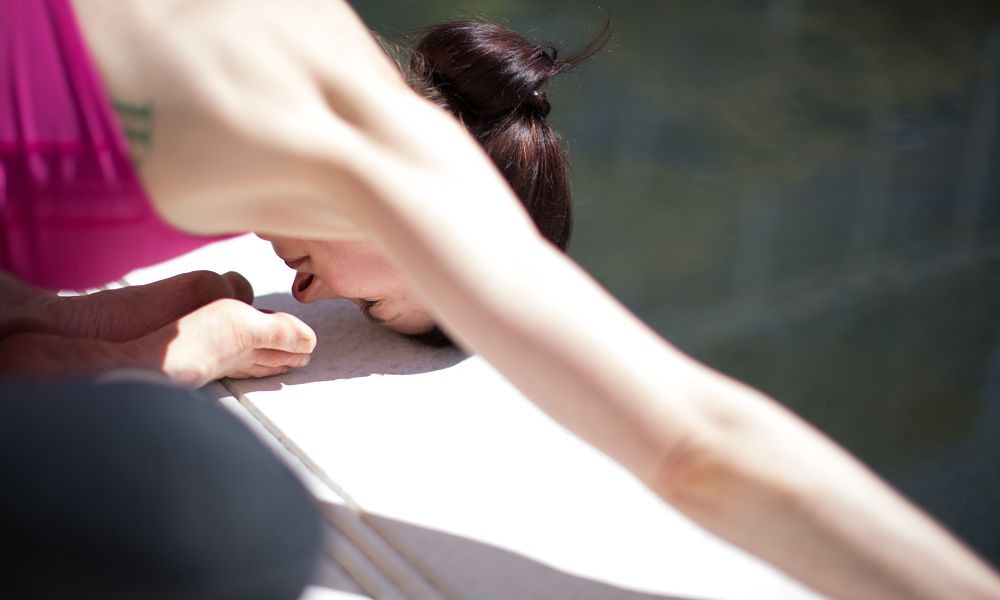Before learning more complicated and complex poses, you may want to start off with something simpler when first trying yoga. Although the beginner yoga poses listed below are simpler, they are nonetheless important and significant for your yoga journey down the road.
Here are just a few beginner yoga poses or asanas to start you off with:
Mountain Pose
Sanskrit Name: Tadasana or Samasthiti
Although this pose may look simple, it is more than just standing in one place and it requires concentration and balance. With your legs spread apart, your toes should be spread and the four corners of your feet should be balancing your weight. Shoulder blades should be pressed back and shoulders should be relaxed. You may choose to have your hands at your chest in a prayer position or arms up above your head. The neck should be aligned with the spine as you relax your facial features and you may close your eyes for a more comfortable position. Breathe in deeply and exhale out. This pose is especially good for practicing a solid breathing exercise.
Tree Pose
Sanskrit Name: Vriksasana
Similar to the Mountain Pose, the Tree Pose involves standing, but only on one leg (switching and alternating each leg as you continue). The easiest way of getting into the pose is by starting in the Mountain pose and finding balance. Then, shifting your weight onto a single leg with hips facing forward, place one foot on the inner side of your thigh (on the leg that is standing and grounded). You can place hands at the heart or chest in prayer position, have hands at hips, or extend arms straight above the head. Once you finish with one side, you can switch onto the other leg, repeating the same steps. If you are not able to place the foot on the inside of the thigh, then you can place or connect the foot at the calf or at the ankle, wherever you feel most comfortable since this pose is good for improving balance.
Cat/Cow Position
Sanskrit Name: Marjaiasana and Bitilasana
The Cat and Cow pose focuses on stretching the lower spine, hips, back and core muscles. Start by placing your hands and knees on the yoga mat while in a tabletop position. Eyes should be looking down at the floor so the neck muscles are relaxed. Slowly inhaling, lift your head and hips upward, making a curve in the spine. Then slowly exhaling, drop the head and hips down.
Child’s Pose
Sanskrit Name: Balasana
This is one of my favorite poses when I am doing yoga. The resting pose allows you to stretch the hips, spine, thighs, and ankles. For an easier transition, you can start in the Cat and Cow pose and then move your body backwards until your hips rest above your ankles and your arms are spread straight and your forehead touches the mat. Make sure to keep your fingers spread on the ground and your shoulders away from your ears. Breathe in deeply and exhale. You can turn your head to the left or right for more comfort and move your arms to the side of your body. Usually, the smooth transition into Child’s pose starts from Chaturanga to Upward-Facing Dog, but for there is more information at Yoga Journal.
Upward-Facing Dog
Sanskrit Name: Urdhva mukha svanasana
Up Dog (or specifically Upward-Facing Dog) is great for stretching the spine. First start by lying face down on the floor with the tops of the feet on the ground and hands under your shoulders. Then, keep your shoulders down and neck elongated as you push up and keep only the tops of your feet on the mat. Keep breathing and make sure to stay relaxed, including keeping your glutes relaxed and not tightened.
Downward-Facing Dog (also known as Downward Dog or Down Dog)
Sanskrit Name: Adho mukha svanasana
Unlike Up Dog, the Down Dog position involves the head to be dropped downward and hips forced back and upwards. This position is also considered a resting pose, but it may take time for some to adjust to the pose before being able to stay for a long period of time. The pose is a great way to stretch the back and calves and heels. With your hands placed at the top of the mat, keep fingers spread for balance and stability. Make sure to keep the shoulders away from the ears so your body makes a reverse “V” shape. If you are just starting out, you may want to keep your knees bent, but otherwise, if you are ready to challenge yourself, you can press your heels down to the floor and keep the legs straight.
There are certainly many other beginning poses you may want to familiarize yourself with (such as the Warrior pose, Bridge pose, Triangle pose, Pigeon pose, and Crow pose), and for more information on them, feel free to go to DoYouYoga. The beginner poses further explained above are some basic poses, but they provide the foundations to yoga. By starting with correct technique and getting the basics down first, you will have an easier journey to attempting more complex poses and positions. Have fun and namaste.

